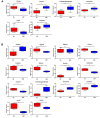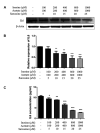Metabolic Profiling of Praziquantel-mediated Prevention of Opisthorchis viverrini-induced Cholangiocyte Transformation in the Hamster Model of Cholangiocarcinoma
- PMID: 33419894
- PMCID: PMC7796817
- DOI: 10.21873/cgp.20239
Metabolic Profiling of Praziquantel-mediated Prevention of Opisthorchis viverrini-induced Cholangiocyte Transformation in the Hamster Model of Cholangiocarcinoma
Abstract
Background: Opisthorchis viverrini (Ov) infection-induced cholangiocarcinoma (CCA) is a major public health problem in northeastern Thailand. Praziquantel was shown to prevent CCA development in an Ov-infected hamster model; however, the molecular mechanism remains unknown.
Materials and methods: In this study, we used a hamster model with Ov and N-nitrosodimethylamine-induced CCA to study the mechanisms of praziquantel action. The liver tissues from the hamsters with and without praziquantel treatment were analyzed using 1H nuclear magnetic resonance spectroscopy.
Results: A total of 14 metabolites were found to be significantly different between the two groups. Furthermore, the combination of acetate, inosine and sarcosine was shown to exert an anti-inflammatory effect through interleukin-6 inhibition in a macrophage cell line, suggesting a mechanism by which praziquantel may prevent inflammation caused by Ov, cholangiocyte transformation and further CCA develpoment.
Conclusion: These findings might avail the development of a preventive strategy for CCA in high-risk populations.
Keywords: Praziquantel; anti-inflammation; cholangiocarcinoma; metabolic profiling; nuclear magnetic resonance spectroscopy..
Copyright© 2021, International Institute of Anticancer Research (Dr. George J. Delinasios), All rights reserved.
Conflict of interest statement
The Authors declare no conflicts of interest.
Figures








Similar articles
-
A combination of praziquantel and the traditional medicinal plant Thunbergia laurifolia on Opisthorchis viverrini infection and cholangiocarcinoma in a hamster model.Parasitol Res. 2013 Dec;112(12):4211-9. doi: 10.1007/s00436-013-3613-y. Epub 2013 Sep 21. Parasitol Res. 2013. PMID: 24057695
-
Decreased risk of cholangiocarcinogenesis following repeated cycles of Opisthorchis viverrini infection-praziquantel treatment: Magnetic Resonance Imaging (MRI) and histopathological study in a hamster model.Parasitol Int. 2017 Aug;66(4):464-470. doi: 10.1016/j.parint.2016.04.012. Epub 2016 Apr 30. Parasitol Int. 2017. PMID: 27143606 Free PMC article.
-
Combination of Praziquantel and Aspirin Minimizes Liver Pathology of Hamster Opisthorchis viverrini Infection Associated Cholangiocarcinoma.Pathol Oncol Res. 2016 Jan;22(1):57-65. doi: 10.1007/s12253-015-9967-y. Epub 2015 Aug 16. Pathol Oncol Res. 2016. PMID: 26277607
-
[Control of Opisthorchis viverrini infection for cholangiocarcinoma prevention].Bull Soc Pathol Exot. 2017 Feb;110(1):61-67. doi: 10.1007/s13149-017-0544-8. Epub 2017 Jan 19. Bull Soc Pathol Exot. 2017. PMID: 28105582 Review. French.
-
Risk Factors for Opisthorchis Viverrini Infection: A Systematic Review.J Infect Public Health. 2020 Sep;13(9):1265-1273. doi: 10.1016/j.jiph.2020.05.028. Epub 2020 Jun 18. J Infect Public Health. 2020. PMID: 32564936
Cited by
-
Quantitative Metabolomics and Lipoprotein Analysis of PDAC Patients Suggests Serum Marker Categories for Pancreatic Function, Pancreatectomy, Cancer Metabolism, and Systemic Disturbances.J Proteome Res. 2024 Apr 5;23(4):1249-1262. doi: 10.1021/acs.jproteome.3c00611. Epub 2024 Feb 26. J Proteome Res. 2024. PMID: 38407039 Free PMC article.
-
Influence of misconceptions and inappropriate eating behaviors on Opisthorchis viverrini infection among at-risk populations undergoing cholangiocarcinoma screening in Northeastern Thailand.Parasitol Res. 2023 Dec;122(12):3131-3138. doi: 10.1007/s00436-023-08003-1. Epub 2023 Oct 19. Parasitol Res. 2023. PMID: 37855971
-
Investigation of the accuracy of magnetic resonance cholangiography and multi-slice spiral computed tomography in the diagnosis of cholangiocarcinoma.J Gastrointest Oncol. 2023 Jun 30;14(3):1496-1503. doi: 10.21037/jgo-22-1294. Epub 2023 Jun 5. J Gastrointest Oncol. 2023. PMID: 37435202 Free PMC article.
-
Reduction of carcinogens in fermented fish (pla-ra and pla-som) by heating.Vet World. 2023 Aug;16(8):1727-1735. doi: 10.14202/vetworld.2023.1727-1735. Epub 2023 Aug 25. Vet World. 2023. PMID: 37766713 Free PMC article.
-
Curcumin and Its Supramolecular Complex with Disodium Glycyrrhizinate as Potential Drugs for the Liver Fluke Infection Caused by Opisthorchis felineus.Pathogens. 2023 Jun 9;12(6):819. doi: 10.3390/pathogens12060819. Pathogens. 2023. PMID: 37375509 Free PMC article.
References
-
- Khuntikeo N, Titapun A, Loilome W, Yongvanit P, Thinkhamrop B, Chamadol N, Boonmars T, Nethanomsak T, Andrews RH, Petney TN, Sithithaworn P. Current perspectives on opisthorchiasis control and cholangiocarcinoma detection in southeast Asia. Front Med. 2018;5:117. doi: 10.3389/fmed.2018.00117. - DOI - PMC - PubMed
-
- Thamavit W, Bhamarapravati N, Sahaphong S, Vajrasthira S, Angsubhakorn S. Effects of dimethylnitrosamine on induction of cholangiocarcinoma in Opisthorchis viverrini-infected Syrian golden hamsters. Cancer Res. 1978;38(12):4634–4639. - PubMed
MeSH terms
Substances
Grants and funding
LinkOut - more resources
Full Text Sources
Other Literature Sources
